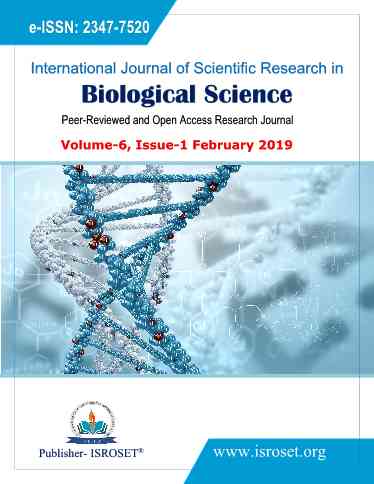Efficiency of Earthworm, Eudrilus Eugeniae (Kinberg, 1867) in The Conversion if Orange Peel (Citrus Sinensis) Waste Mixed with Diclofenac Into Compost
Keywords:
vermicompost, FTIR, Eudrilu eugniae, Orange peel waste, Macro, micro Nutrients, histological studiesAbstract
The efficiency of the earthworm Eudrilus eugeniae was studied in the present work where the earthworm was subjected to the conversion of Orange peel waste mixed with diclofenac into compost in the form of micro and macro minerals on 15th and 30th days. Micro and Macro nutrients such as N, P, K and Fe, Mn, Zn, Cu were analyzed in the Orange peel waste and mixed with diclofenac along with control. Similarly physical characteristics were also analyzed to understand the efficiency of earthworm in maintaining the physical status of the soil. The analysis revealed that the P and Fe were increased significantly on 15th and 30th days where as the Physical property i.e., EC was increased only in the orange peel waste conversion where as in the diclofenac contaminated waste, the EC was stable in the present study. The pH was slightly increased on 15th and stable on 30th day. FTIR Study was undertaken to identity the chemical group present in the control and experiment. Histological changes were compared with that of experiment and the efficiency of the earthworm has been understood in the present work within a short period of 15th to 30th days.
References
Prabha .L.M, Jayraaj .I.A, and Jeyaraaj .R, Macro and Micronutrient changes in vermicomposting of vegetable wastes using Eudrilus eugeniae. - South Asian Journal of Socio-Political Studies, 2, 129-130, 156, 2005.
Lal .O.P, Srivastava .Y.N and Singa .S.R. Vermicomposting. - Indian Farming, k 52 6-8, 2003.
Bansal, S., Kapoor, K.K., Vermicomposting of crop residues and cattle dung with Eisenia foetida. Bioresour. Technol. 73, 95–98, 2000.
Sinha, R.K., Heart, S., Agarwal, S., Asadi, R. &Carretero, E. Vermiculture and Waste management: study of action of earthworms Eisenia foetida, Eudrilus eugeniae and Perionyx excavates. On biodegradation of some community wastes in India and Australia. –Environmentalist22: 261-268. 2002.
Garg.P Gupta.A and Satya.S. Vermicomposting of different types of waste using Eisenia foetida; a comparative study. Biores. Technol., V., 97, No. 3, pp. 391-395, 2006.
Ismail, S.A., Vermitechnology: The biology of earthworms. Orient Longman Limited, Chennai, 1997.
Gajalakshmi, S., Ramasamy, E.V. and Abbasi, S.A. ‘Vermicomposting of paper Waste with the anecic earthworm Lampito mauritii Kinberg’, Indian J. Chem. Technol., Vol. 9, pp. 306-311. 2002.
Kumerer K. (2010) Pharmaceuticals in the Environment Annu Rev Energ. Environ. 35, 57,
Sallmann A.R. The history of diclofenac. Amer. J. Med. 80, (4B), 29, 2012.
Gan T.J. 2010. Diclofenac: An update on its mechanism of action and safety profile .Curr. Med. Res. Opin.26, (7), 1715, 2010.
Lee, K. E., Some trends opportunities in earthworm research or: Darwin’s children. The future of our discipline. Soil Biol. Biochem., 24: 1765 – 1771, 1992.
Satchell, K. Martein, Phosphate activity earthworm faeces.Soil Biology and Biochemistry, 16, 191–194. 1984.
Le Bayon R.C. and Binet, F. Earthworm changes the distribution and availability of phosphorus in organic substrates, J. Soil Biol.Biochem, 38, 235–246, 2006.
Lopez H., A., Casarrubias U., Z. y Leal H.R., studio geologic regional de la Zona geothermic de Las Tres virgenes, B.C.S, C.F.E. –G.P.G., internal report: OGL/BC/ 002/93,39P, 1993.
Roy S.K, Trehan. S.P and Sharma. R.C, Long term nutrient management in potato-sun" ower- rice system for sustainable productivity. In: Intl. Conference on Managing Natural Resources, New Delhi. Extended Summaries.3: 920-921, 2000.
Atiyeh, R.M., Dominguez, J., Subler, S., Edwards, C.A., Changes in biochemical Properties of cow manure during processing by earthworms (Eisenia andrei Bouche) and the effects on seedling growth. Pedobiologia 44, 709–724, 2000.
Nogales, R., Cifuentes, C., Benítez, E., Vermicomposting of winery wastes: a Laboratory study. J. Environ. Sci. Health. 40, 659–673, 2005.
Senapati, B. K., Dash, M. C., Rana, A. K. and Panda, B. K., Observations on the Effect of earthworm in decomposition process in soil under laboratory conditions.Comp.Physiol. Ecol., 5: 140-142, 1980.
Ilangovan S and Lethi CD. Study of the quality of vermicomposting by Lampito Mauritii from Pondicherry and Eisenia foetida from Cochin and Ooty, India. Ind. J. Natural Science, 11, 1046-1050. 2012.
Kaviraj, Sharma., Municipal solid waste management through vermicomposting Employing exotic and local species of earthworm.Biores Technol, 90, 69–173, 2003.
Mitchell A, (1997). Production of Eisenia fetida and vermicompost from feed-lot cattle manure. Soil Biol. Biochem, 29, 763-766, 1997.
Elvira, C., Sampeelro, L., Benitez, E and Nagales, R. ‘Vermicomposting of sledges’ from paper mill and dairy industries with Eisenia andrei: a plot scale study’, Bioresour. Technol., Vol 62, pp. 205-211, 1998.
Downloads
Published
How to Cite
Issue
Section
License

This work is licensed under a Creative Commons Attribution 4.0 International License.
Authors contributing to this journal agree to publish their articles under the Creative Commons Attribution 4.0 International License, allowing third parties to share their work (copy, distribute, transmit) and to adapt it, under the condition that the authors are given credit and that in the event of reuse or distribution, the terms of this license are made clear.







